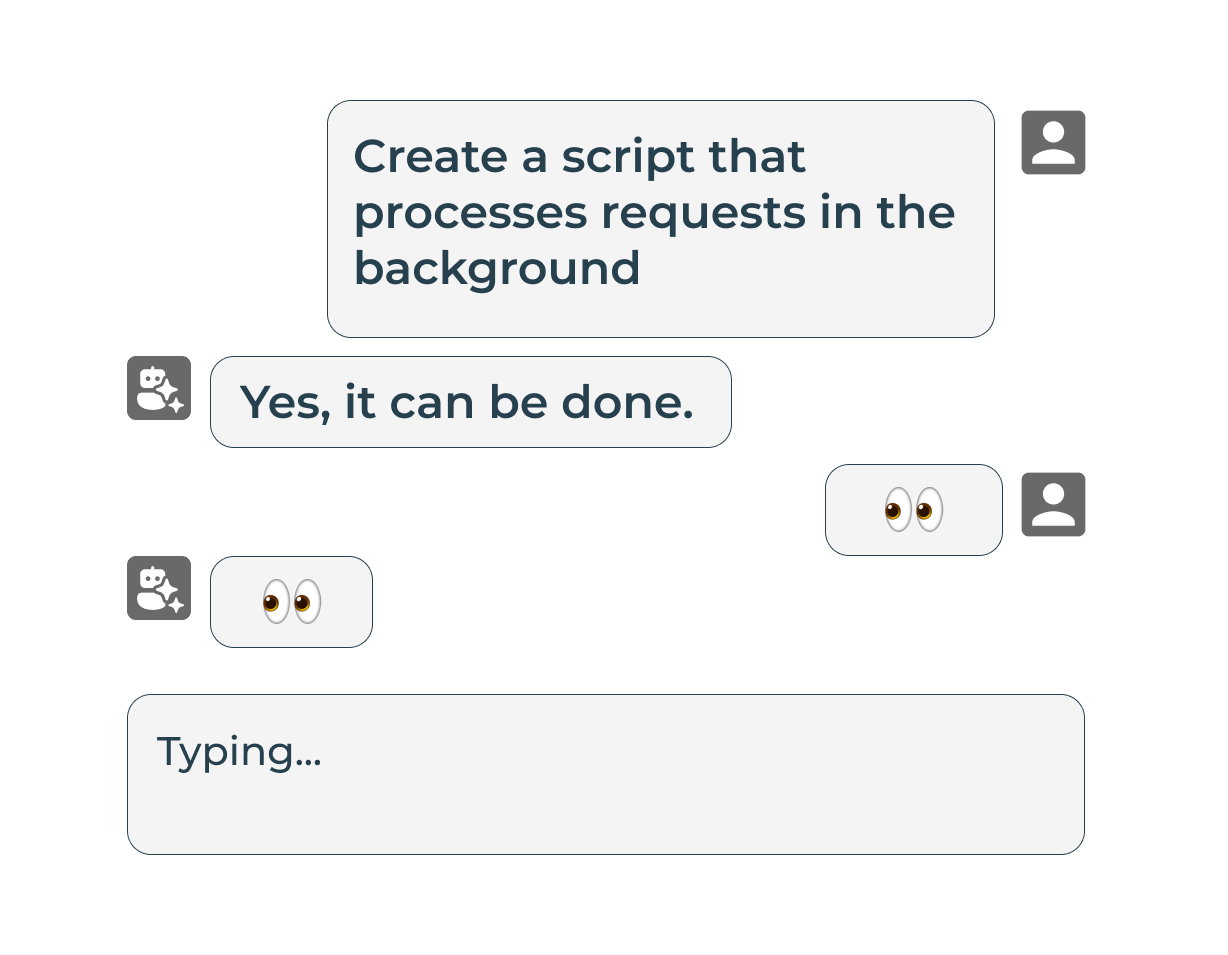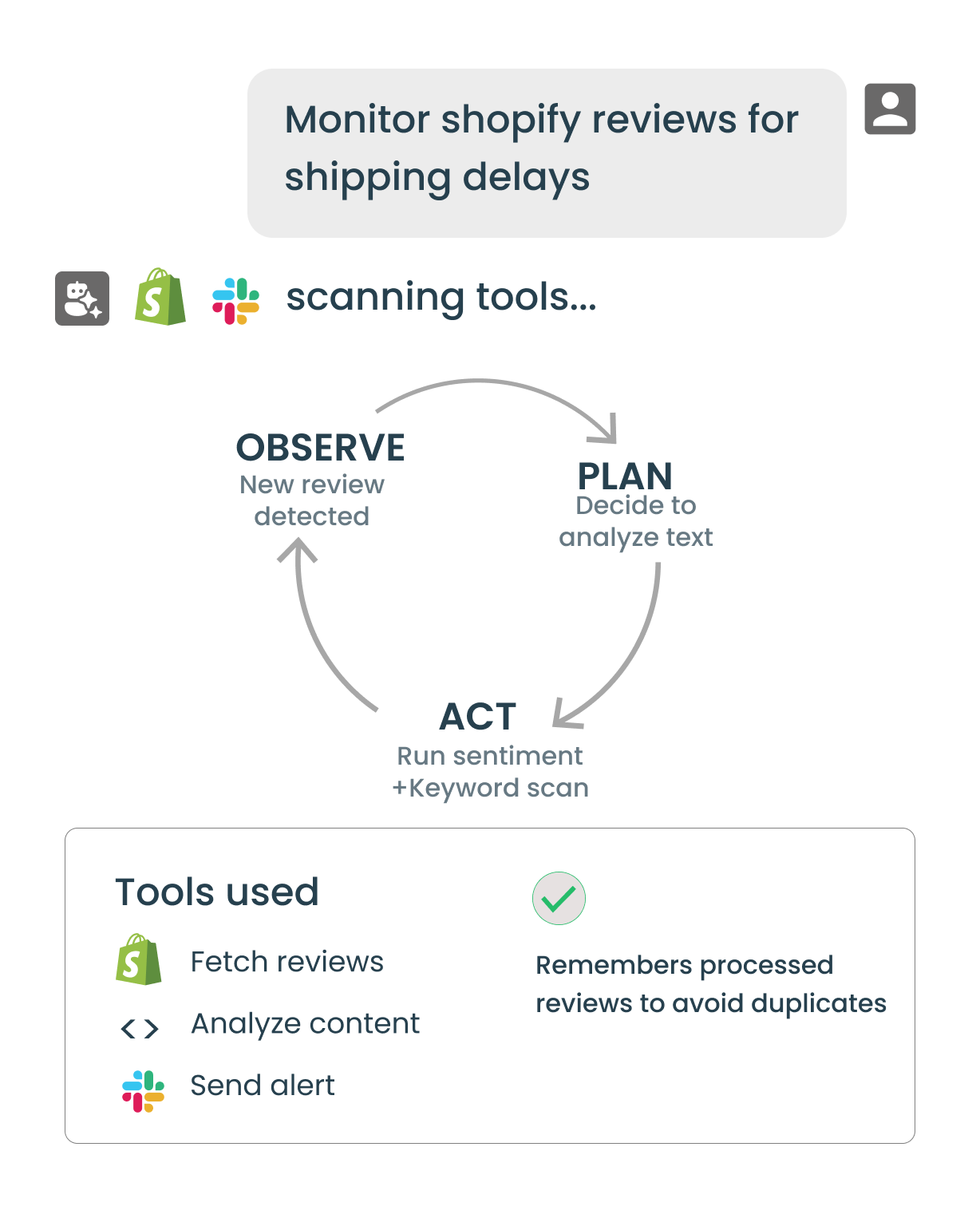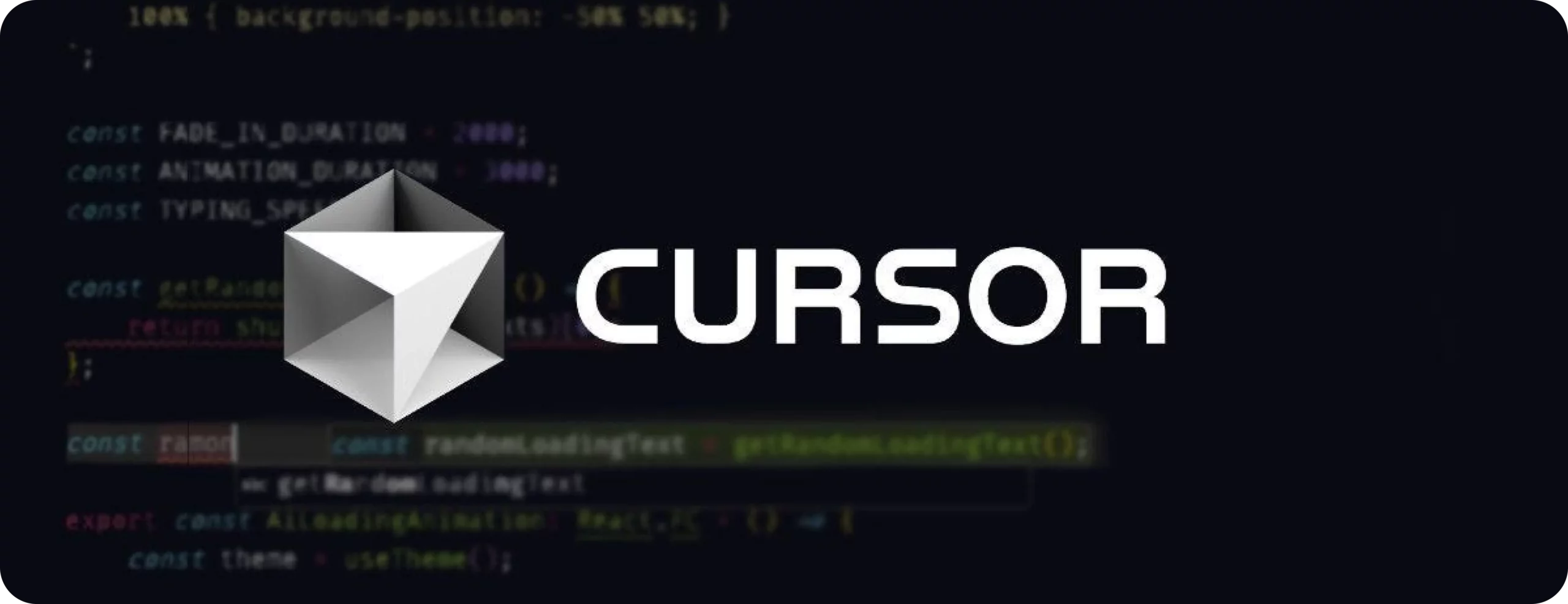

What is an AI agent? A jargon-free guide for engineers
The moment AI stops talking and starts doing, you get an AI agent.
Most engineers have tried LLMs by now. We’ve asked ChatGPT to generate code, draft emails, or debug errors. They’re powerful thinking tools. But they stop short of execution. If you want the task to actually happen, say, pull data, update a dashboard, send a message, you still have to do it yourself or write code to glue things together.
The next evolution is already underway. It’s called AI agents. And they’re designed to act, not just react.
This guide is for engineers who want a practical, hype-free understanding of AI agents. What they are. How they work. What they’re good for. And how to start building with them today.
Limitations of traditional AI tools and why agents matter
Modern AI tools are impressive, but they’re also passive. They generate responses, suggest edits, write code, summarize text. But once that output is on your screen, it just sits there. The AI doesn’t know what happens next. It doesn’t act or follow through. So, engineers fill the gap.
We build wrappers around OpenAI APIs. We write scripts to trigger workflows, call APIs, and move data between tools. We patch together vector databases, cron jobs, and scheduling logic to give our smart assistants a bit of autonomy. But it’s fragile and ends up with dozens of moving parts, timeout errors, mismatched payloads, and long chains of glue code that break the moment a schema changes.
And here’s the catch: most of these flows aren’t complex. They’re just fragmented. You don’t need another model. You need something that can take initiative. That’s why engineers and the world are turning to AI agents.
Instead of just responding, an AI agent observes the environment, makes decisions, and takes actions toward a goal. It can fetch data, run tests, post updates, and trigger code, all without needing step-by-step instructions for each action. This shift, from passive tools to autonomous agents, is driving the next phase of AI-powered developer workflows.
Somewhere along the way, the world moved on.
Your customers changed how they search, shop, and make decisions. Your employees changed how they code, research, and create. Meanwhile, most enterprises are still stuck running “AI transformation” decks and funding pilots that never leave the lab.
The numbers tell the story:
- 95% of organizations report zero measurable ROI from AI (Axios, Tom’s Hardware).
- Only 48% of AI projects ever reach production (Informatica).
- 67% of firms can’t get even half their pilots out of the lab (ITPro).
The enterprise AI curve? Flat and expensive.
And here’s the thing: it’s not a tech problem, it’s a structural one.
- Consumers don’t need governance committees to use ChatGPT.
- Enterprises, on the other hand, wrestle with messy data, security reviews, and process overhauls, just to survive the next audit.
Innovation doesn’t wait for approvals. Your enterprise can’t afford to either.
What is an AI agent? Definition and overview
An AI agent is a program that takes a goal and tries to achieve it by deciding what actions to take, in what order, and using which tools. It doesn’t wait for you to tell it every step. It figures things out.
Think of it like a junior developer you can trust with outcomes, not just instructions. You don’t need to micromanage it. You give it context, access to tools, and a goal. Then it gets to work.
For example, say the goal is “monitor our API response times and alert me if latency spikes.” An AI chatbot would reply with suggestions or sample code. An agent would actually run the checks, compare results to thresholds, and send alerts when needed. And that’s the difference.
An AI agent has a sense of state. It can reason about what’s happening, choose a next action, and loop that process until the goal is complete or the workflow fails.
AI agents vs traditional automation: Key differences
At first glance, AI agents might sound like just another flavour of automation. But there’s a key difference.
Traditional automation is static as it follows a fixed path. You define the steps, hardcode the logic, and it does exactly what you told it to do. Yes, some automations today are dynamic with the help of LLMs, but the fact remains, they are rigid, confined.
AI agents are dynamic in all essence of the term. They start with a goal, look at the current state, decide the next best step, and adjust as needed.
For example, take a flow that sends a Slack alert when a new row is added to a Google Sheet. That’s automation. It does one job, with no context beyond the trigger.
Now, imagine an agent given the same goal. It could check if the data is valid, fetch related entries, summarize them, and decide whether a notification is even needed. If it fails, it could retry or escalate. All without you hardcoding every branch.
That kind of flexibility is what makes agents powerful as they bring reasoning to the workflow, not just execution.
Of course, they’re not perfect, and we’re only at the brink of this subject. But unlike most automation tools, they can handle ambiguity. They don’t need every edge case spelt out. And they can coordinate across tools in ways that would be painful to stitch together manually.
If regular automation is like running a recipe, AI agents are more like telling a sous-chef, “make something light and spicy,” and trusting them to figure out the rest.
AI agent examples and use cases
Before we talk about famous use cases, let’s start with everyday ones. If you’ve ever wished someone else could:
- Read incoming support tickets and draft replies
- Monitor a log file and create a bug ticket when something breaks
- Fetch daily metrics, spot anomalies, and alert the right Slack channel
- Review a pull request, check for missing tests, and assign it to the right reviewer
Then you’ve already imagined what an AI agent could do.
These are exactly the kinds of high-volume, low-judgment tasks that agents are being built to handle.
That said, while AI agents are gaining momentum, most companies are still in the early stages. According to a 2024 survey, fewer than 15 percent of teams have production-ready agents integrated into core workflows. And those who do are typically running narrow, well-scoped agents, not fully autonomous coworkers.
Still, we’re seeing signs of real adoption from companies that even the most non-technical reader would recognize.
- GitHub introduced Copilot Workspace, an early example of an agent-like system that doesn’t just suggest code but plans tasks, generates multiple steps, and handles project context. It’s still experimental, but it points to where dev tools are headed.
- Shopify has been experimenting with AI agents to help merchants. In one example shared by their team, an agent helps business owners troubleshoot store performance issues by running diagnostics and surfacing suggestions in natural language — instead of showing raw metrics.
- Microsoft is integrating agentic behaviors into Copilot for Office. It’s not just about writing slides anymore. These agents can pull CRM data into Excel, cross-reference it with your calendar, and summarize it in a doc. It’s narrow, but still a form of autonomous action.
These are running in real environments today; just behind the scenes, and with strong guardrails.
AI agents just haven’t scaled widely yet, and that’s actually a good thing. Because the teams who are experimenting today are helping define the patterns that the rest of us will build on tomorrow.
And that’s where it gets exciting because as a developer, you don’t need to wait for a company-wide rollout. You can start small, with one task and let an agent take it from there.
Technical components of an AI agent: Tools, memory, logic
Most AI agents follow a simple loop: look at what’s going on, decide what to do, take action, repeat.
But under the hood, there’s a bit more structure. At the core, an AI agent typically has four key parts:
- Planner – figures out what steps are needed to reach the goal
- Memory – keeps track of what’s been done, what failed, what’s next
- Tools – the actual functions or APIs it can use to get work done
- Controller – manages the flow between all of the above and keeps the agent on track
To make these agents enterprise-grade, they also need:
- Strong security and governance (role-based access, audit logs).
- Deep integrations into legacy systems.
- Transparent decision trails for compliance and accountability.
In essence, AI agents don’t just automate tasks, they run parts of the business, safely and intelligently.
For example, if the goal is to triage a bug report, the agent might:
- Read the incoming ticket
- Search past tickets for similar issues
- Check the logs via API
- Draft a reply or open a pull request
- Notify the right teammate
Each of those steps involves looking at context, deciding what’s relevant, and choosing an action from a toolkit. None of this requires deep ML knowledge. Most agents today are built using existing LLMs (like GPT-4 or Claude) and simple code scaffolding around them.
And while some setups include advanced memory stores or custom models, many developers are getting started with just a prompt template, a task loop, and a few APIs.
The key idea is this: you don’t need to hardcode the whole workflow. You give the agent the tools and the goal, and let it figure out the rest. That’s what makes it feel human-like. Not because it’s intelligent, but because it can adapt.
AI agent components explained with an example:
Let’s say you want to build an AI agent that monitors Shopify reviews and alerts your team if someone mentions a shipping delay. Here’s how the core components come together:
- Goal: Give the agent a clear outcome – “Watch for new product reviews. If any mention a delay, alert the CX team.”
- Reasoning loop: The agent runs a loop –
observe → plan → act → reflect
This lets it adapt to different inputs and outcomes, instead of following a rigid script. - Tools: The agent uses APIs or functions to get work done:
- Shopify Reviews API (input)
- Text analyzer (sentiment + keywords)
- Slack webhook (alert)
- Memory: It remembers which reviews were already processed or flagged, so it doesn’t repeat work.
Getting started with AI agents: Tools, frameworks, and first steps
The fastest way to understand AI agents is to build one that completes a full task loop without requiring you to intervene between steps.
Pick a task that already feels like boilerplate. Something that reads data, makes a decision, and triggers an action. Not a demo. A real workflow that already exists.
Then build the smallest version of an agent that can handle it end to end.
Here’s how to do that, depending on how close to the internals you want to work:
Code-first frameworks
Use these if you want control over memory, planning, execution, and fallback logic.
- LangGraph: Python framework for defining stateful agents with loop control and persistent memory. Best for custom flows with evolving context.
- AutoGen: Agent orchestration based on structured messages. You define roles and tools. It handles stepwise interaction and tool use.
- CrewAI: Lightweight abstraction for coordinating agents with roles and goals. Good for rapid prototyping of delegation and interaction patterns.
Hosted and visual platforms
Skip setup and focus on task logic. These are best when you want working agents without managing infrastructure.
- Dust: Hosted agent runtime with observability, tool integration, and long-term memory support.
- Flowise: Drag-and-drop builder for chaining LLMs, tools, and decision logic. Useful for workflows and demos.
Agent builders
These platforms let you define and deploy agents with reasoning and tool access. They are built for production workflows, not just automation.
- Retool Agents: Embedded agent layer inside Retool. Agents can act on APIs, databases, and UI events with observability and permissioning built in.
- Zapier Agents: Lets you create agents in natural language with access to over 7,000 apps. Designed for business tasks like lead qualification, routing, or ticket updates.
- Appsmith Agents: Context-aware agents built inside Appsmith apps. Can operate through UI, Slack, or browser extensions using live business data.
Build-it-yourself
If you want to construct your own loop from scratch:
- Use GPT-4, Claude, or Mistral with function-calling
- Wrap your internal tools or APIs as callable functions
- Add memory using Chroma, Weaviate, or a local store
- Use queues or schedulers for timed tasks
- Test locally using Flask, FastAPI, or any backend framework
You don’t need every option on this list. You need one working agent that completes a task without help. Once that loop holds, you’ll know what to build next.
Where this is headed (and where it breaks)
The agent pattern is evolving fast, but it’s not mature. Most teams experimenting with agents today are still figuring out where they break before they scale.
The most common failure points aren’t about the model they’re about the system around it. Agents struggle when:
- goals are vague or nested too deeply
- tools fail silently or return inconsistent outputs
- there’s no clear boundary between one step and the next
Multi-agent systems add more surface area: race conditions, redundant work, or loops that never exit. Without proper isolation, two agents can end up undoing each other’s progress.
This is where standards come in. Agent-to-agent protocols like A2A define how agents can coordinate without stepping on each other. MCP servers help structure tool access and track execution. These don’t make agents smarter. They just give the system shape.
Read also, Popular MCP servers to explore for your AI journey >
If you’re hitting problems, the fix often isn’t smarter prompts. It’s rethinking how the work is scoped and sequenced. Most agent failures are design failures.
From passive tools to programmable collaborators
Agents are still early, and so are the patterns around them.
What’s clear is that they don’t fit neatly into existing tooling, and they won’t succeed just by being added to a stack. They require better defaults, better visibility, and better questions from the teams using them.
If there’s value here, it’s not in the autonomy itself but in the pressure it puts on design.
Well-scoped goals. Reliable tools. Clear contracts. Whether you’re building with a framework or an agent builder, that’s the real work.
Everything else is just movement.





